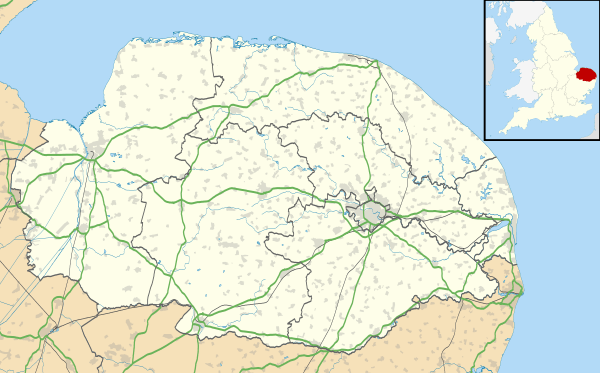Kettlestone
Kettlestone is a village and civil parish in the English county of Norfolk. It covers an area of 7.55 km2 (2.92 sq mi) and had a population of 177 in 85 households at the 2001 census,[1] increasing to 197 at the 2011 Census.[2] For the purposes of local government, it falls within the district of North Norfolk.
| Kettlestone | |
|---|---|
Jun2006.jpg) Kettlestone Church | |
 Kettlestone Location within Norfolk | |
| Area | 7.55 km2 (2.92 sq mi) |
| Population | 197 (2011) |
| • Density | 26/km2 (67/sq mi) |
| OS grid reference | TF968317 |
| Civil parish |
|
| District | |
| Shire county | |
| Region | |
| Country | England |
| Sovereign state | United Kingdom |
| Post town | FAKENHAM |
| Postcode district | NR21 |
| Police | Norfolk |
| Fire | Norfolk |
| Ambulance | East of England |
It is situated about 5 miles (8.0 km) to the east of the market town of Fakenham. The village has several farms and a small church. Also included in the parish is Pensthorpe home of the Pensthorpe Nature Reserve.[3] The village is broadly aligned east to west about a single street with houses mainly to the north.
History
The village dates back to the time of the Domesday Book. The village church is built of the local flint stone and is thought to date from the 13th century. The tower which dates from the 14th century is unusual for Norfolk in that it is octagonal (Norfolk churches tend to have square towers, or occasionally round towers). The church was extensively restored in the Victorian period, work being completed in 1871. Inside the church is a 500-year-old font with shields showing the lion and the fleur-de-lys of England and France, the keys of Peter and the swords of Paul, the arms of the see of Norwich (the church is within the Anglican Diocese of Norwich), and the emblem of the Trinity.
A memorial in the church to William Newman tells us that in thanks for the kindness shown to him when he was brought up here as a poor London boy in the 18th century he left £500 to the poor of Kettlestone forever.
The lychgate is a 20th-century memorial to James Cory, rector of Kettlestone for 68 years until his death in 1864, who is buried in the churchyard. He began as rector in 1796, and hence was preaching during the French Revolution, Trafalgar and Waterloo, the Crimean War and the Indian Mutiny.
Notes
- Census population and household counts for unparished urban areas and all parishes. Office for National Statistics & Norfolk County Council (2001). Retrieved 20 June 2009.
- "Parish population 2011". Retrieved 4 September 2015.
- Archived 20 November 2008 at the Wayback Machine Kettlestone Parish Council Retrieved 24 October 2008
External links
| Wikimedia Commons has media related to Kettlestone. |
Kettlestone Parish Council website https://web.archive.org/web/20110725051753/http://www.norfolkrcc.org.uk/wiki/index.php/Kettlestone_Parish_Council
References
- Much of this material is mentioned in THE KING'S ENGLAND – NORFOLK – Green Pastures and Still Waters, edited by Arthur Mee, Hodder & Stoughton, London, 1940.